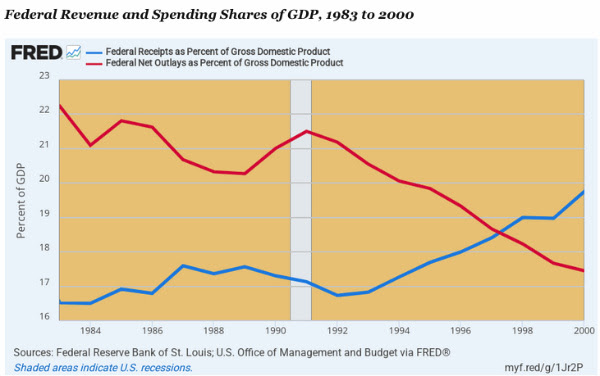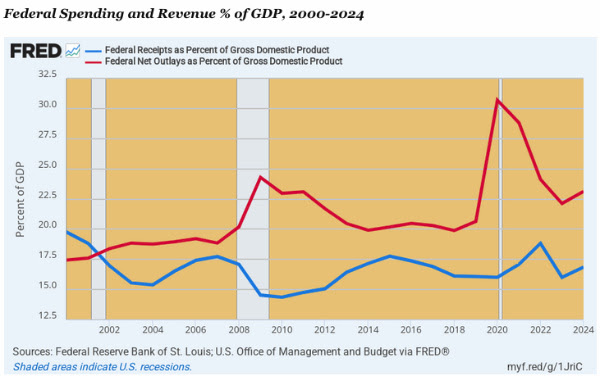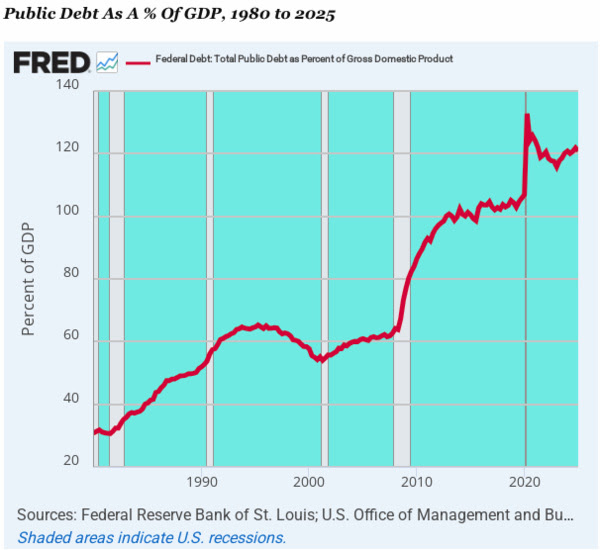As of 1980, the rolling 10-year and 20-year real GDP growth rates stood at 3.2% per annum and 3.5% per annum, respectively.
Owing to a slight boost from the good parts of Reaganomics—sweeping deregulation, tax rate cuts, and sound money, which were partially offset by the long-term ills owing to the abandonment of balanced budgets—the respective moving averages rose a tad to 3.5% and 3.6% per year by 1988, respectively.
Still, these rounding error gains in the moving averages of growth should be a reminder that whatever its philosophical virtues—and they were considerable—Reaganomics did not usher in a decisive or even measurable break from prior trends. That is to say, 1960 to 1980 was pretty much the heyday of Keynesian economics in Washington, and the 20-year moving average of growth at its endpoint in 1980 was 3.5%.
Yet in 1989, after a decade of Reaganomics–and at which point Bush the Elder had not yet moved his lips on tax increases—the 10-year moving average stood at, well, 3.1%. In other words, there was not a dime’s—nay, even a penny’s—worth of difference in the economic growth trend between the pre-1981 era of Keynesian economics and the half-assed version of supply-side economics implemented in the 1980s.
Of course, after that, we got what amounted to Washington pragmatism, embodied in the tax increase and spending cut packages of Bush the Elder in 1990 and Bill Clinton in 1995.
What happened, of course, is the Federal budget was brought back to surplus, but this persistent withdrawal of so-called “stimulus”—whether viewed as supply-side tax incentives or Keynesian demand-side fiscal juice—did not detract from the almighty “growth” rate in the slightest. In fact, by the year 2000 when the Federal government ran a culminating +1.8% of GDP surplus, the 10-year moving average of growth stood at 3.2%, exactly where it had posted in 1980.
That is to say, after a round trip from Harvard Keynesianism through supply-side and back to the Wall Street-tinted Keynesian playbook under Bob Rubin and Larry Summers in the late 1990s, the trend of the growth needle barely moved. The saving grace, of course, is that 3.2% per annum growth wasn’t all that bad.
Between 1980 and 2000, in fact, even as the Federal government was clawing its way back to balanced budgets and temporarily eschewing the practice of shifting the tax burden to future workers, the real median family income grew from $69,700 to $84,600 or by a healthy 1.0% per annum.

But that’s all she wrote. As of 2024, the true long-term economic weather vane—the 20-year moving average of real GDP growth—had fallen to just 2.0% or barely half the 1988 peak. And you can pin the tail on the two negative legacies that emerged from Ronald Reagan’s eight years in the Oval Office. These were—
- the horrid money-printing, Keynesianized version of central banking monetary central planning inaugurated by Alan Greenspan.
- The Dick Cheney proclamation that Federal deficits don’t matter much, thereby putting a stake in whatever was left of the balance budget religion in the GOP after $950 billion of Reagan deficits over 1981-1988.
Subsequent to the year 2000, of course, fiscal deficits returned and soared, and the Fed money-printers went bonkers. That is to say, the US economy experienced the greatest combined injection of fiscal and monetary stimulus ever. Yet the rise of real median family income ran out of stream!
Per Annum Growth In Real Median Family Income:
- 1960-1980: 1.93%.
- 1980 to 2000: 0.97%.
- 2000-2024: 0.76%.
Still, it wasn’t for lack of trying down on the banks of the Potomac. In fact, as of 2024, Federal spending was back up to 23.2% of GDP while Uncle Sam’s tax take from national income was back down in the sub-basement of modern history at 17.0% of GDP. Accordingly, the fiscal gap stood at the same 6.2% level of GDP, which had been first breached in peacetime during the dark days of 1983.
But this time, closing the resulting 6.2% GDP gap will be far, far harder than it proved to be during the Reagan era and the 1990s. That’s because the Fed has now shot its wad and has essentially hung itself out to dry on an inflationary $7 trillion balance sheet.
Yet, with inflation still stubbornly high, in excess of 3% per year, the Fed is in no position to clear the bond pits of Uncle Sam’s excess debt emissions via a resumption of madcap QE. The latter systematic falsification of bond prices and yields peaked at a staggering $120 billion per month of bond purchases before the pivot in March 2022.
Yet US Treasury debt emissions will soon hit $3 trillion per year. That means, in turn, that the UniParty clowns on both ends of Pennsylvania Avenue will soon find themselves on a fiscal treadmill worthy of a medieval torture wheel.
To wit, Federal debt service costs on what will soon be $40 trillion of public debt will now rise by $700 billion per year in the face of even a 150 basis points rise in bond yields. And that happens to be the entirety of the Medicaid savings that the GOP RINOs are now fixing to the gut.
As the man said, however, what are they going to do for an encore? When interest rates notch up steadily higher even as the public debt climbs by $3 trillion per year, the GOP’s spending cut cupboard will be bare by its own omission, having ruled out any cuts at all in Social Security, Medicare, Veterans, Defense, and interest payments or upwards of three-fourths of the budget.

While this may sound grim as a matter of future financial reality, what is even more outlandish is that the knuckleheads in the Trumpified GOP are wasting the meager savings in food stamps and Medicaid they had managed to cobble together on the following increases to the already bloated $1.0 trillion Pentagon budget.
For crying out loud, the annual cost of America’s invincible triad strategic nuclear force is just $75 billion per year, and another $200 billion or so would be more than enough for an impenetrable Fortress America defense of the continental shorelines and airspace.
Yet all the rest—upwards of $700 billion—goes to the service of Empire. That is, the capacity to fight Forever Wars we don’t need and to field global forces of invasion and occupation, which do absolutely nothing for the true Homeland Security of America.
In a word, the once former GOP Watchdog of the Treasury is lost because it gave up the balanced budget axiom during Reagan’s times for the siren song of growing your way out of debt or stabilizing the public debt at the current high fixed ratio to GDP.
The latter seems to be the game plan of Trump’s Treasury Secretary Scott Bessent, who was 18 years old when Ronald Reagan was elected on a campaign pledge to balance the Federal budget. Yet, at that time, the public debt stood at 30% of GDP, not today’s 120%.
Then again, we were apparently benighted back in 1981 when we launched a plan to balance the budget by 1984, which would have pegged the debt ratio at 33% of GDP and pushed it steadily lower as far as the eye could see as the US economy continued to expand.
According to Bessent-O-Nomics, by contrast, we should have been marching in the other direction—driving full speed ahead with massive deficits until we reached the promised land at 120% of GDP, where Uncle Sam would be, presumably, carrying just the right amount of debt!

In short, Scott Bessent is full of Wall Street bullshit.
He wants to sound “responsible” on the fiscal front yet not disturb the Washington fiscal game by allowing that deficits at 3% of GDP each year are just fine because if the economy grows by 3%, the towering debt-to-GDP ratio of the present time won’t get any worse!
Indeed, it is truly hard to think of a more pitiful attempt to rationalize the status quo in the guise of high principle.
And as for “growing your way out,” the bottom line is straightforward. The CBO baseline already embodies 2% real growth and 4% nominal GDP gains per year. And that’s all there is, there ain’t no more.
